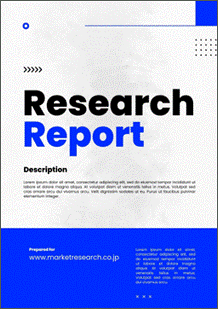 | • レポートコード:MRC2303B099 • 出版社/出版日:Mordor Intelligence / 2023年1月 • レポート形態:英文、PDF、150ページ • 納品方法:Eメール(受注後2-3営業日) • 産業分類:化学 |
| Single User | ¥712,500 (USD4,750) | ▷ お問い合わせ |
| Corporate License | ¥1,312,500 (USD8,750) | ▷ お問い合わせ |
• お支払方法:銀行振込(納品後、ご請求書送付)
レポート概要
| Mordor Intelligence社の本市場調査レポートでは、世界の化粧品用顔料市場規模が、予測期間中(2022年~2027年)に年平均6.25%で成長すると展望しています。本書は、化粧品用顔料の世界市場について総合的に分析し、イントロダクション、調査手法、エグゼクティブサマリー、市場動向、用途別(顔用メイクアップ、リップ製品、ヘアカラー製品、アイメイクアップ、その他)分析、組成別(無機物、有機物)分析、地域別(中国、インド、日本、韓国、アメリカ、カナダ、メキシコ、ドイツ、イギリス、イタリア、フランス、ブラジル、アルゼンチン、サウジアラビア、南アフリカ)分析、競争状況、市場機会・将来の動向などの項目を整理しています。さらに、参入企業として、Croda International PLC、DIC CORPORATION、ECKART、GEOTECH、IFC Solutions、Kobo、Koel Colours Pvt. Ltd、LANXESS、Merck KGaA、Neelikon、Ocres de France、Sandream Impact LLC、Sensient Cosmetic Technologies、Sudarshan Chemical Industries Limited、Sun Chemicalなどの情報を含んでいます。 ・イントロダクション ・調査手法 ・エグゼクティブサマリー ・市場動向 ・世界の化粧品用顔料市場規模:用途別 - 顔用メイクアップにおける市場規模 - リップ製品における市場規模 - ヘアカラー製品における市場規模 - アイメイクアップにおける市場規模 - その他における市場規模 ・世界の化粧品用顔料市場規模:地域別 - アジア太平洋の化粧品用顔料市場規模 中国の化粧品用顔料市場規模 インドの化粧品用顔料市場規模 日本の化粧品用顔料市場規模 … - 北米の化粧品用顔料市場規模 アメリカの化粧品用顔料市場規模 カナダの化粧品用顔料市場規模 メキシコの化粧品用顔料市場規模 … - ヨーロッパの化粧品用顔料市場規模 ドイツの化粧品用顔料市場規模 イギリスの化粧品用顔料市場規模 イタリアの化粧品用顔料市場規模 … - 南米/中東の化粧品用顔料市場規模 ブラジルの化粧品用顔料市場規模 アルゼンチンの化粧品用顔料市場規模 サウジアラビアの化粧品用顔料市場規模 … - その他地域の化粧品用顔料市場規模 ・競争状況 ・市場機会・将来の動向 |
The market for cosmetic pigment is expected to register a CAGR of over 6.25% during the forecast period (2022-2027).
The COVID-19 pandemic had a negligible impact on the market. However, the market has been estimated to grow steadily during the forecast period.
Key Highlights
- The major factors driving the market studied are the increasing demand for cosmetics products in the Asia-Pacific region and the rapidly growing demand for organic pigments.
- On the flip side, new medical technologies for beauty enhancement are expected to hinder the growth of the market.
- The organic pigments segment is estimated to be the fastest-growing composition type in the cosmetic pigments market over the forecast period.
- The Asia-Pacific region represents the largest market and is also expected to be the fastest-growing market over the forecast period owing to the increasing consumption from countries such as China, India, Japan, and South Korea.
Cosmetic Pigments Market Trends
Inorganic Pigment Segment to Continue its Dominance
- Inorganic pigments are chemical compounds not based on carbon and are usually metallic salts precipitated from solutions.
- These pigments can be defined as insoluble compounds with a basis of metallic ions. Inorganic pigments are generally very resistant to the effects of light because the energy required to generate a breakdown of bonds is greater than that provided by sunlight.
- Most inorganic pigments are manufactured at high temperatures and are generally not affected by the process temperatures, making them resistant to heat.
- Inorganic colors (pigments) are composed of insoluble metallic compounds derived from natural sources (e.g., china clay, carbon deposits) or are synthesized. Inorganic pigments consist of iron oxides, chromium oxides, ultramarines, manganese violet, white pigments, and pearlescent effects.
- The high stability of inorganic pigment color and high particle dispersion make it a popular choice in the manufacture of cosmetics products. The dispersion benefits of inorganic pigment are expected to increase the industry’s growth rate and the development of the worldwide inorganic pigment market in the coming years.
- Therefore, due to the above-mentioned factors, the inorganic pigments segment is likely to dominate the cosmetic pigments market during the forecast period.
Asia-Pacific Region to Dominate the Market
- Currently, the Asia-Pacific region dominates the global market for the cosmetic pigments market. China and Japan are the leading consumers of cosmetic pigments in the region.
- The increasing cosmetic production capacities and consumption in countries such as China, India, and ASEAN countries, are expected to increase the demand for cosmetic pigments in the region.
- The estimated revenue of face products in China was USD 2,842.4 million in 2020. It is projected to reach USD 4,986.3 million in 2025. Also, the estimated revenue of lip products in the country was USD 3,121.5 million in 2020, and it is expected to be USD 5,011.4 million in 2025.
- The estimated revenue of face products in India was USD 1,312.9 million in 2020, and it is projected to reach USD 2,037.2 million in 2025. Also, the estimated revenue of lip products in the country was USD 1,282.3 million in 2020, and it is likely to reach USD 1,825.9 million in 2025.
- All these factors are expected to make the Asia-Pacific region dominate the global market.
Cosmetic Pigments Market Competitor Analysis
The global cosmetic pigments market is consolidated, with players accounting for a marginal share in the market. Some of the major companies (in no particular order) include DIC CORPORATION, Atlanta, Merck KGaA, Venator Materials PLC, and Fujian Kuncai Material Technology Co. Ltd.
Additional Benefits:
- The market estimate (ME) sheet in Excel format
- 3 months of analyst support
1 INTRODUCTION
1.1 Study Assumptions
1.2 Scope of the Study
2 RESEARCH METHODOLOGY
3 EXECUTIVE SUMMARY
4 MARKET DYNAMICS
4.1 Drivers
4.1.1 Increasing Demand for Cosmetic Products in the Asia-Pacific Region
4.1.2 Rapidly Growing Demand for Organic Pigments
4.2 Restraints
4.2.1 New Medical Technologies for Beauty Enhancement
4.2.2 Other Restraints
4.3 Industry Value Chain Analysis
4.4 Porter’s Five Forces Analysis
4.4.1 Bargaining Power of Suppliers
4.4.2 Bargaining Power of Consumers
4.4.3 Threat of New Entrants
4.4.4 Threat of Substitute Products and Services
4.4.5 Degree of Competition
5 MARKET SEGMENTATION
5.1 Application
5.1.1 Facial Makeup
5.1.2 Lip Products
5.1.3 Hair Colour Products
5.1.4 Eye Makeup
5.1.5 Other Applications
5.2 Composition
5.2.1 Inorganic
5.2.2 Organic
5.3 Geography
5.3.1 Asia-Pacific
5.3.1.1 China
5.3.1.2 India
5.3.1.3 Japan
5.3.1.4 South Korea
5.3.1.5 Rest of Asia-Pacific
5.3.2 North America
5.3.2.1 United States
5.3.2.2 Canada
5.3.2.3 Mexico
5.3.3 Europe
5.3.3.1 Germany
5.3.3.2 United Kingdom
5.3.3.3 Italy
5.3.3.4 France
5.3.3.5 Rest of Europe
5.3.4 South America
5.3.4.1 Brazil
5.3.4.2 Argentina
5.3.4.3 Rest of South America
5.3.5 Middle-East
5.3.5.1 Saudi Arabia
5.3.5.2 South Africa
5.3.5.3 Rest of Middle-East
6 COMPETITIVE LANDSCAPE
6.1 Mergers and Acquisitions, Joint Ventures, Collaborations, and Agreements
6.2 Market Share (%)**/Ranking Analysis
6.3 Strategies Adopted by Leading Players
6.4 Company Profiles
6.4.1 Croda International PLC
6.4.2 DIC CORPORATION
6.4.3 ECKART
6.4.4 GEOTECH
6.4.5 IFC Solutions
6.4.6 Kobo
6.4.7 Koel Colours Pvt. Ltd
6.4.8 LANXESS
6.4.9 Merck KGaA
6.4.10 Neelikon
6.4.11 Ocres de France
6.4.12 Sandream Impact LLC
6.4.13 Sensient Cosmetic Technologies
6.4.14 Sudarshan Chemical Industries Limited
6.4.15 Sun Chemical
7 MARKET OPPORTUNITIES AND FUTURE TRENDS